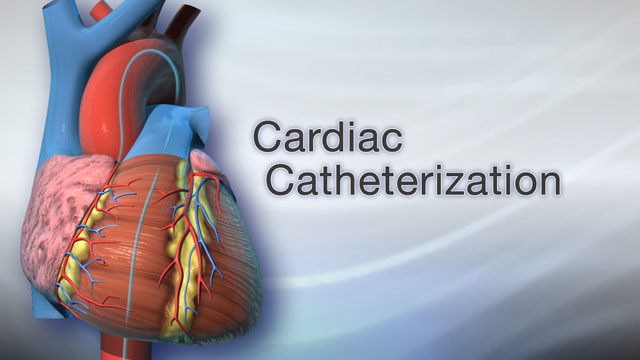Left heart catheterization
Catheterization - left heart
Left heart catheterization is the passage of a thin flexible tube (catheter) into the left side of the heart. It is done to diagnose or treat certain heart problems.
How the Test is Performed
You may be given a mild medicine (sedative) before the procedure starts. The medicine is to help you relax. The health care provider will place an IV into your arm to give medicines. You will lie on a padded table. Your doctor (most often a heart specialist called a cardiologist) will make a small puncture on your body near one of your arteries. A flexible tube (catheter) is inserted into and threaded through the artery. It will be placed in your wrist, arm or your upper leg (groin). You will most likely be awake during the procedure.
Live x-ray pictures are used to help guide the catheters up into your heart and arteries. Dye (sometimes called "contrast") will be injected into your body. This dye will highlight blood flow through the arteries. This helps show blockages in the blood vessels that lead to your heart.
The catheter is then moved through the aortic valve into the left side of your heart. The pressure is measured in the heart in this position. Other procedures can also be done at this time, such as:
- Ventriculography to check the heart's pumping function.
- Coronary angiography to look at the coronary arteries.
- Angioplasty, with or without stenting, to correct blockages in the arteries is then performed.
The procedure may last from less than 1 hour to several hours.

How to Prepare for the Test
In most cases, you should not eat or drink for 8 hours before the test. (your cardiologist may give you different directions.)
The procedure will take place in the hospital. You may be admitted the night before the test, but it is more common to come to the hospital the morning of the procedure. In some cases, this procedure is done after you have already been admitted to the hospital possibly on an emergency basis.
You will wear a hospital gown. Your cardiologist will explain the procedure and its risks. You must sign a consent form.
How the Test will Feel
The sedative will help you relax before the procedure. However, you will be awake and able to follow instructions during the test.
You will be given local numbing medicine (anesthesia) before the catheter is inserted. You will feel some pressure as the catheter is inserted. However, you should not feel any pain. You may have some discomfort from lying still for a long period of time.
Why the Test is Performed
The procedure is done to look for:
- Cardiac valve disease
- Cardiac tumors
- Heart defects (such as ventricular septal defects)
- Problems with heart function
The procedure may also be done to evaluate and possibly repair certain types of heart defects, or to open a narrowed heart valve.
When this procedure is done with coronary angiography to examine the arteries that feed the heart muscle, it can be done with angioplasty to open blocked arteries or bypass grafts. This can be because of a heart attack or angina.
The procedure can also be used to:
- Collect blood samples from the heart
- Determine pressure and blood flow in the heart's chambers
- Take x-ray pictures of the left ventricle (main pumping chamber) of the heart (ventriculography)
Normal Results
A normal result means the heart is normal in:
- Size
- Motion
- Thickness
- Pressure
The normal result also means arteries are normal.
What Abnormal Results Mean
Abnormal results may be a sign of cardiac disease or heart defects, including:
- Aortic insufficiency
- Aortic stenosis
- Coronary artery disease
- Heart enlargement
- Mitral regurgitation
- Mitral stenosis
- Ventricular aneurysms
- Atrial septal defect
- Ventricular septal defect
- Heart failure
- Cardiomyopathy
Risks
Complications may include:
- Cardiac arrhythmias
- Cardiac tamponade
- Embolism from blood clots at the tip of the catheter to the brain or other organs
- Heart attack
- Injury to the artery
- Infection
- Kidney damage from contrast (dye)
- Low blood pressure
- Reaction to the contrast material
- Stroke
References
Dengas GD, Mehran R. Coronary angiography and intravascular imaging. In: Libby P, Bonow RO, Mann DL, Tomaselli GF, Bhatt DL, Solomon SD, eds. Braunwald's Heart Disease: A Textbook of Cardiovascular Medicine. 12th ed. Philadelphia, PA: Elsevier; 2022:chap 21.
Kern MJ, Seto AH, Hermann J. Invasive hemodynamic diagnosis of cardiac disease. In: Libby P, Bonow RO, Mann DL, Tomaselli GF, Bhatt DL, Solomon SD, eds. Braunwald's Heart Disease: A Textbook of Cardiovascular Medicine. 12th ed. Philadelphia, PA: Elsevier; 2022:chap 22.
Lawton J, Tamis-Holland, J. et al. 2021 ACC/AHA/SCAI Guideline for coronary artery revascularization: A report of the American College of Cardiology/American Heart Association Joint Committee on Clinical Practice Guidelines. J Am Coll Cardiol. 2022;79(2):e21–e129. PMID: 34895950 pubmed.ncbi.nlm.nih.gov/34895950/.
Review Date: 7/14/2024















